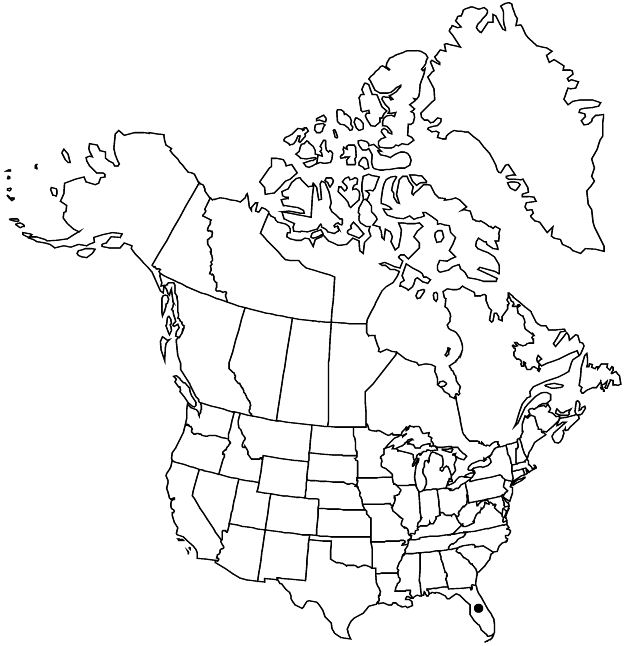Difference between revisions of "Acalypha wilkesiana"
Prodr. 15(2): 817. 1866.
FNA>Volume Importer |
imported>Volume Importer |
||
| Line 32: | Line 32: | ||
|elevation=0–10 m. | |elevation=0–10 m. | ||
|distribution=Fla.;Pacific Islands;introduced also in Mexico;West Indies;Central America;n South America;se Asia;Africa. | |distribution=Fla.;Pacific Islands;introduced also in Mexico;West Indies;Central America;n South America;se Asia;Africa. | ||
| + | |introduced=true | ||
|discussion=<p><i>Acalypha wilkesiana</i> is not known in the wild, but presumably originated in the southwestern Pacific Islands (Bismarck Archipelago east to Fiji). The species is commonly cultivated as an ornamental for its leaves that may be various shades of green, purple, red, orange, and yellow (sometimes variegated), and sometimes contorted into unusual shapes. Despite low seed set, it occasionally becomes naturalized in tropical and subtropical areas. Naturalized plants often lack the distinctive leaf coloration found in cultivated plants. Although sometimes treated as A. amentacea subsp. wilkesiana, DNA sequence data show that <i>A. wilkesiana</i> and A. amentacea are distinct species (V. G. Sagun et al. 2010).</p> | |discussion=<p><i>Acalypha wilkesiana</i> is not known in the wild, but presumably originated in the southwestern Pacific Islands (Bismarck Archipelago east to Fiji). The species is commonly cultivated as an ornamental for its leaves that may be various shades of green, purple, red, orange, and yellow (sometimes variegated), and sometimes contorted into unusual shapes. Despite low seed set, it occasionally becomes naturalized in tropical and subtropical areas. Naturalized plants often lack the distinctive leaf coloration found in cultivated plants. Although sometimes treated as A. amentacea subsp. wilkesiana, DNA sequence data show that <i>A. wilkesiana</i> and A. amentacea are distinct species (V. G. Sagun et al. 2010).</p> | ||
|tables= | |tables= | ||
| Line 56: | Line 57: | ||
|publication year=1866 | |publication year=1866 | ||
|special status=Introduced | |special status=Introduced | ||
| − | |source xml=https:// | + | |source xml=https://bibilujan@bitbucket.org/aafc-mbb/fna-data-curation.git/src/bb6b7e3a7de7d3b7888a1ad48c7fd8f5c722d8d6/coarse_grained_fna_xml/V12/V12_613.xml |
|genus=Acalypha | |genus=Acalypha | ||
|species=Acalypha wilkesiana | |species=Acalypha wilkesiana | ||
Revision as of 20:11, 27 May 2020
Shrubs, 20–50 dm, monoecious. Stems erect, sparsely to densely pubescent, not glandular. Leaves persistent; petiole 1–6 cm; blade ovate to broadly ovate or suborbiculate, 9–20 × 4–15 cm, base obtuse to rounded or subcordate, margins serrate-crenate, apex acuminate. Inflorescences usually unisexual, rarely bisexual, axillary; staminate peduncle 0.1–1.5 cm, fertile portion 10–20 cm; pistillate peduncle 1–2 cm, fertile portion 4–15 × 0.5–0.8 cm; bisexual similar to staminate, with 1–2 pistillate bracts near base; allomorphic pistillate flowers absent. Pistillate bracts loosely arranged (inflorescence axis visible between bracts), 2–4 × 3–5 mm, abaxial surface sparsely to moderately pubescent; lobes 7–9, ovate to lanceolate, 1/4 bract length, except terminal lobe to 1/2 bract length. Pistillate flowers: pistil 3-carpellate; styles multifid or laciniate. Capsules unknown. Seeds unknown.
Phenology: Flowering spring–fall.
Habitat: Old home sites, disturbed areas.
Elevation: 0–10 m.
Distribution

Introduced; Fla., Pacific Islands, introduced also in Mexico, West Indies, Central America, n South America, se Asia, Africa.
Discussion
Acalypha wilkesiana is not known in the wild, but presumably originated in the southwestern Pacific Islands (Bismarck Archipelago east to Fiji). The species is commonly cultivated as an ornamental for its leaves that may be various shades of green, purple, red, orange, and yellow (sometimes variegated), and sometimes contorted into unusual shapes. Despite low seed set, it occasionally becomes naturalized in tropical and subtropical areas. Naturalized plants often lack the distinctive leaf coloration found in cultivated plants. Although sometimes treated as A. amentacea subsp. wilkesiana, DNA sequence data show that A. wilkesiana and A. amentacea are distinct species (V. G. Sagun et al. 2010).
Selected References
None.